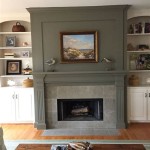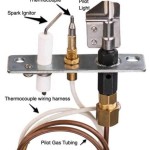How To Install Fireplace Surround Tile: A Comprehensive Guide
Installing fireplace surround tile is a project that can dramatically enhance the aesthetic appeal of a living space, transforming a simple fireplace into a focal point. While it requires patience, careful planning, and attention to detail, the process is manageable for a dedicated do-it-yourselfer. This guide provides a comprehensive overview of the steps involved, ensuring a successful and visually appealing outcome.
Before embarking on the installation, several essential aspects need consideration. Selecting the right tile is paramount. The type of tile chosen should complement the existing décor and withstand the heat generated by the fireplace. Popular options include ceramic, porcelain, natural stone (such as slate or marble), and even specialized fireplace tiles. The size and shape of the tile will also influence the visual impact and the complexity of the installation process. Furthermore, ensuring the structural integrity of the existing fireplace surround is critical. Any repairs or reinforcement should be addressed before tiling commences.
Gathering the necessary tools and materials is crucial for a smooth and efficient installation process. These typically include: tile, thin-set mortar, grout, tile spacers, a notched trowel, a wet saw or tile cutter, a grout float, a sponge, a measuring tape, a level, a pencil, safety glasses, and gloves. Depending on the condition of the existing surface, additional items such as a scraper, sandpaper, and primer may also be required.
Preparing the Surface for Tile Installation
Proper surface preparation is arguably the most critical step in ensuring a successful tile installation. The existing surface must be clean, level, and structurally sound. Begin by thoroughly cleaning the fireplace surround, removing any dust, debris, old paint, or adhesive residue. A scraper can be used to remove stubborn materials. If the surface is uneven, it may be necessary to apply a leveling compound to create a smooth and uniform base. Allow the leveling compound to dry completely before proceeding.
Once the surface is clean and level, it's essential to prime it. Primer enhances adhesion between the thin-set mortar and the existing surface, preventing the tile from detaching over time. Apply a thin, even coat of primer using a brush or roller and allow it to dry completely according to the manufacturer's instructions. In some cases, a scratch coat of thin-set mortar may be applied instead of primer. This involves applying a thin layer of mortar to create a textured surface that promotes better adhesion.
After priming, it's advisable to dry-fit the tiles before applying any mortar. This involves arranging the tiles on the surface to determine the optimal layout and identify any necessary cuts. Use tile spacers to maintain uniform gaps between the tiles. Pay close attention to the alignment and symmetry of the layout. This dry-fitting process helps prevent errors and ensures a visually pleasing final result. Mark any necessary cuts on the tiles using a pencil and a measuring tape.
Applying Thin-Set Mortar and Setting the Tile
With the surface prepared and the tiles dry-fitted, the next step is to apply the thin-set mortar. Thin-set mortar is the adhesive that bonds the tile to the underlying surface. Mix the thin-set mortar according to the manufacturer's instructions, using a mixing bucket and a drill with a mixing attachment. The consistency of the mortar should be similar to that of peanut butter – smooth, spreadable, and not too runny.
Using a notched trowel, apply a layer of thin-set mortar to a small section of the fireplace surround. The size of the notched trowel will depend on the size and type of tile being used. Hold the trowel at a 45-degree angle and create ridges in the mortar. These ridges provide channels for air to escape and ensure better adhesion. Work in small sections to prevent the mortar from drying out before the tiles are set.
Carefully position the tiles onto the mortar bed, pressing them firmly into place. Use tile spacers to maintain consistent gaps between the tiles. Periodically check the level of the tiles to ensure they are aligned correctly. If necessary, gently tap the tiles with a rubber mallet to adjust their position. Remove any excess mortar from the surface of the tiles with a damp sponge.
After all the tiles are set, allow the thin-set mortar to dry completely according to the manufacturer's instructions. This typically takes 24 to 48 hours. Avoid disturbing the tiles during this drying period to prevent them from shifting or becoming misaligned.
Grouting and Cleaning the Tile Surround
Once the thin-set mortar has fully dried, it's time to grout the tile surround. Grout fills the gaps between the tiles, providing a watertight seal and enhancing the overall appearance. Select a grout color that complements the tile and the surrounding décor. Mix the grout according to the manufacturer's instructions.
Apply the grout to the tile surround using a grout float. Hold the float at a 45-degree angle and spread the grout diagonally across the tile surface, forcing it into the gaps between the tiles. Remove any excess grout from the surface of the tiles with the grout float. Work in small sections and wipe away excess grout as you go.
After the grout has had a chance to set (typically 15 to 30 minutes), use a damp sponge to clean the surface of the tiles. Rinse the sponge frequently in clean water. Be careful not to remove too much grout from the gaps between the tiles. Repeat this process several times until the tile surface is clean and free of grout residue.
Allow the grout to cure completely according to the manufacturer's instructions. This typically takes several days. During this curing period, it's essential to keep the grout moist by periodically spraying it with water. This helps the grout to harden properly and prevents it from cracking.
Once the grout has fully cured, buff the tile surface with a clean, dry cloth to remove any remaining grout haze. Inspect the tile surround for any imperfections and make any necessary repairs. Finally, apply a grout sealer to protect the grout from staining and water damage. Sealing the grout will help to maintain its color and prevent it from deteriorating over time.

How To Tile A Fireplace My Uncommon Slice Of Suburbia

Diy Tiling A Fireplace Surround What We Learned Along The Way

How To Install A Marble Herringbone Fireplace Surround And Hearth

How To Prep A Fireplace For New Tile House One
/102661017-6a23c040b71843379188b96b21ac1a08.jpg?strip=all)
How To Tile A Fireplace

How To Tile A Fireplace Surround And Hearth Build Basic

How To Tile A Fireplace Even If It S Brick The Handyman Daughter

How To Tile Over An Existing Fireplace Surround My Woodlands Life

Tiling A Fireplace Surround Home Improvement Stack Exchange Blog

How To Tile A Fireplace House One
Related Posts








